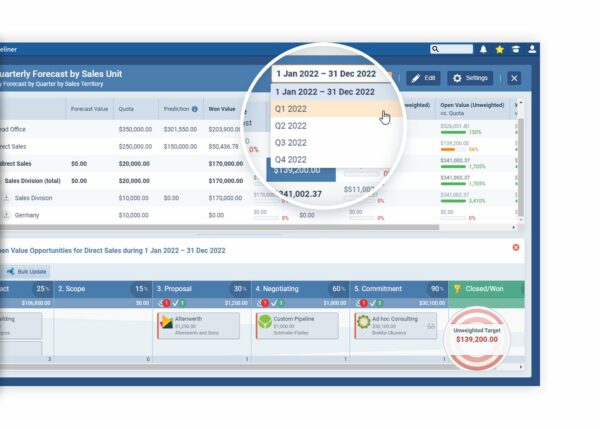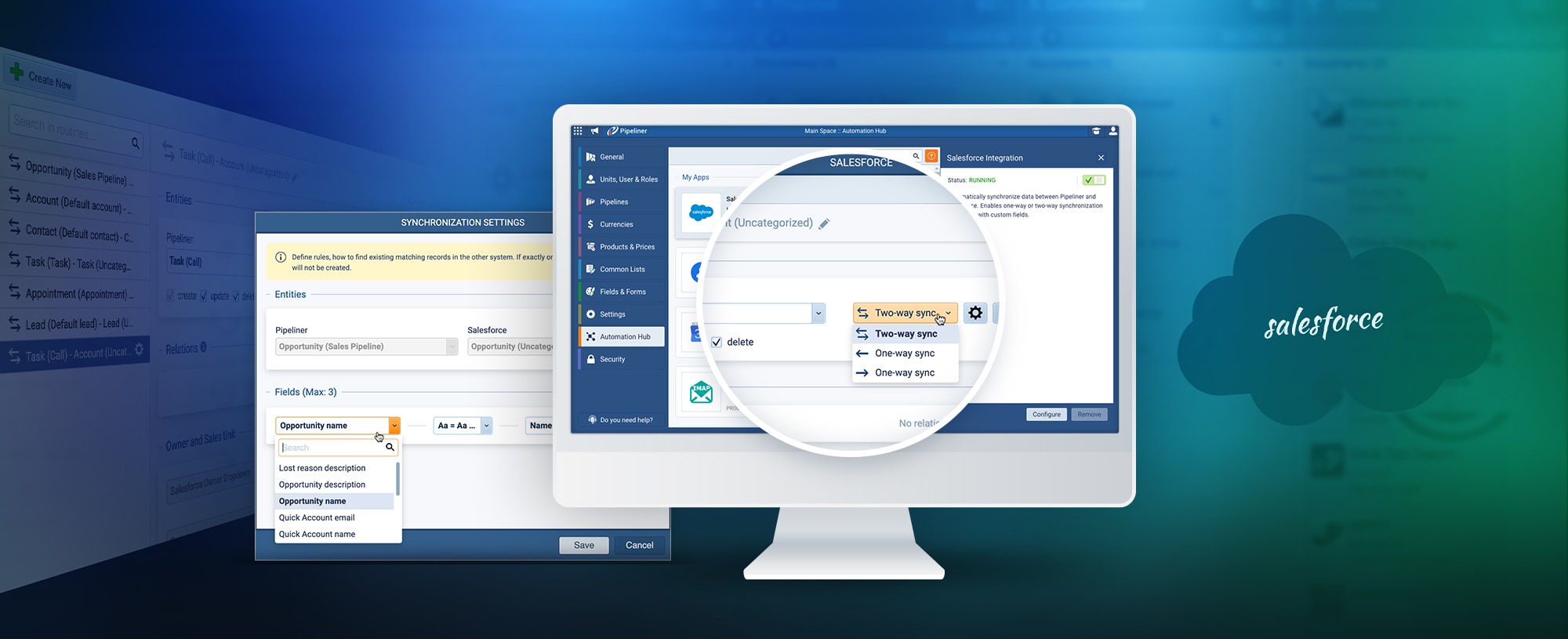For a sales team to be truly effective, it must successfully manage its pipelinePipeline Sales pipelineis a visual representation of the stage prospects are in the sales process.. Fundamentally, pipeline management is the act of monitoring and managing prospective consumers from the time they enter your sales funnelSales Funnel Sales Funnel is a visualization of the sales process that defines the stages through which prospective customers go through as they are led by sales professionals towards a purchasing decision. until they become paying clients. Boosting the effectiveness of your sales force and completing more transactions entails assessing and improving each step of the sales processSales Process Sales Process is a series of strategic steps or a set of activities aimed at driving sales growth through the alignment of personnel, market insight, methodologies, relevant business units, and technology..
The fundamental difference between Pipeliner CRM and any other pipeline management tool is that we not only define the sales process, but the precise activities that must be completed per sales process step. With its last two releases, that process has been optimized even more. In addition to basing sales activity on buyerBuyer A buyer is an individual or organizational entity that purchases a product or subscribes to a service. action, we have now added the option for chosen opportunities to be approved by management before they are moved further in the sales process steps.
Let’s walk through general sales pipelineSales Pipeline Sales Pipeline is a type of visualization showing the status of each sales prospect in the customer life cycle or sales process. management, and examine how Pipeliner CRM can boost your company’s growth and profits.
Management of Pipelines: Its Significance
Effective pipeline management is essential for sales teams to hit their quotas and reach their revenueRevenue Revenue is the amount of money a business generates during a specific period such as a year or a quarter; also called sales. targets. Sales staff can identify potential leads, track developments, and prioritize prospects with the best chances of closing when an effective pipeline management system is in place.
An effective pipeline management system does not only exist in the sales process, but in the activities within the process. What kind of appointments, tasks, or activities should the salespeople engage in, based on the prospect’s reactions and attitudes? Pipeliner CRM has implemented this combination of buyer action and sales activity. Approval of movement from one step to the next, based on buyer action and sales activity, is perfect management.
Austrian management consultant, author and educator Peter Drucker said that you can only manage what you can measure. You can only effectively measure a team based on the sales process steps and the activities they are instructed to take within each step.
Pipeline management not only keeps sales teams organized, but also enables managers to see bottlenecks and potential areas for development. Managers may obtain insights into the efficacy of their sales tactics and make dataData Data is a set of quantitative and qualitative facts that can be used as reference or inputs for computations, analyses, descriptions, predictions, reasoning and planning.-driven choices to streamline their operations by measuring key performance indicators (KPIs), including conversionConversion Conversion is the process of turning a target consumer into a paying customer; or more generally, the point at which a user performs a specific action favorable to a marketer or a seller. rates, deal sizes, and win rates.

Implementing Pipeline Management: A Guide
A clearly defined procedure and the appropriate tools are needed to implement an efficient pipeline management system. The essential phases in establishing a pipeline management system for your sales force are as follows:
Establish Your Sales Steps
Identifying the various steps of your sales process is the first action in pipeline management. Typically, the steps cover lead generationLead Generation Lead Generation is a set of activities aimed at generating interest around a product or service through methods such as 1. content marketing (blogging, podcasts, free downloads); 2. advertising (PPC, banner ads, Yellow Pages, sponsoring an event); 3. referrals (recommendations from existing customers and other people); 4. outbound marketing (cold email, cold calling), and 5. partnerships (joint ventures, affiliate marketing)., leadLead Lead refers to a prospect or potential customer (who can be an individual or organization) that exhibits interest in your service or product; or any additional information about such entity. qualifying, productProduct Product refers to anything (an idea, item, service, process or information) that meets a need or a desire and is offered to a market, usually but not always at a price. demonstration, proposal, negotiationNegotiation Negotiation is a strategic dialogue, discussion, or bargaining process between two or more parties with the goal of reaching a mutually acceptable agreement., and closure stages. To achieve uniformity across the team, each of these steps needs to have explicit criteria and KPIs.
Calculate Lead Scores
Giving leads grades based on how likely they are to close is a useful technique for prioritizing leads. Many variables, including firm size, industry, budget, and level of participation, can be used to determine lead scores. This increases the likelihood of success by enabling sales representatives to concentrate on the most promising prospects.
You will also need to know your conversion rates. That is:
- What is your lead conversion rate? How many leads do you need to convert from cold to warm?
- How many warm leads will be needed to convert a warm lead into an opportunity?
- How many opportunities will it take to make a closed deal?
Working out these numbers and relationships will show you how many leads and opportunities you need in each step to make a certain number of closed deals.
Follow Your Development
Monitoring your progress is essential for managing your pipeline. Monitoring crucial metricsMetrics Metrics are quantities that are measured and used to:, such as the number of leads in each pipeline step, conversion rates, and win rates, is necessary to achieve this. You may pinpoint areas for improvement and create data-driven decisions to improve your sales process by monitoring these KPIs.
Use Sales Facilitation Tools
It will be impossible to run your pipeline management procedure without a CRM. The CRM should include lead-scoring tools and sales analyticsAnalytics Analytics is the active study of different types of data with the aim of discovering meaningful patterns and translating these into insight (such as historical analyses and forecasts), or action (such as those intended to improve business performance). platforms. These technologies operate within a single platform for tracking leads and important information about how well your sales methods are working.
Improve the sales process
Pipeline management, and everything else involved with sales, should be implemented in iterations. No long-term strategy and activity, including pipeline management and CRM, can be accomplished 100 percent all at once, hence iterations are vital. From the beginning, you’ll be defining your sales process, process steps, and activities and tasks to be taken within steps. Get it up and running, and learn to optimize the system on the fly.
Pipeliner is the only CRM that allows you to make changes instantly and therefore optimize the system by iterations.
You may enhance your strategy and raise your chances of success by frequently analyzing your sales process and identifying opportunities for improvement. Maintaining the effectiveness and efficiency of your sales process entails reviewing data, experimenting with novel ideas, and asking your team for feedback.
Conclusion
Any sales team seeking to increase growth and revenue must use pipeline management. Sales teams can make wise judgments and use their time and resources efficiently by monitoring and optimizing each step of the sales process, and all tasks and activities within each step. Using a successful pipeline management system dramatically improves the effectiveness of your sales force and assists you in meeting your revenue targets with the correct tools and a well-defined procedure.





